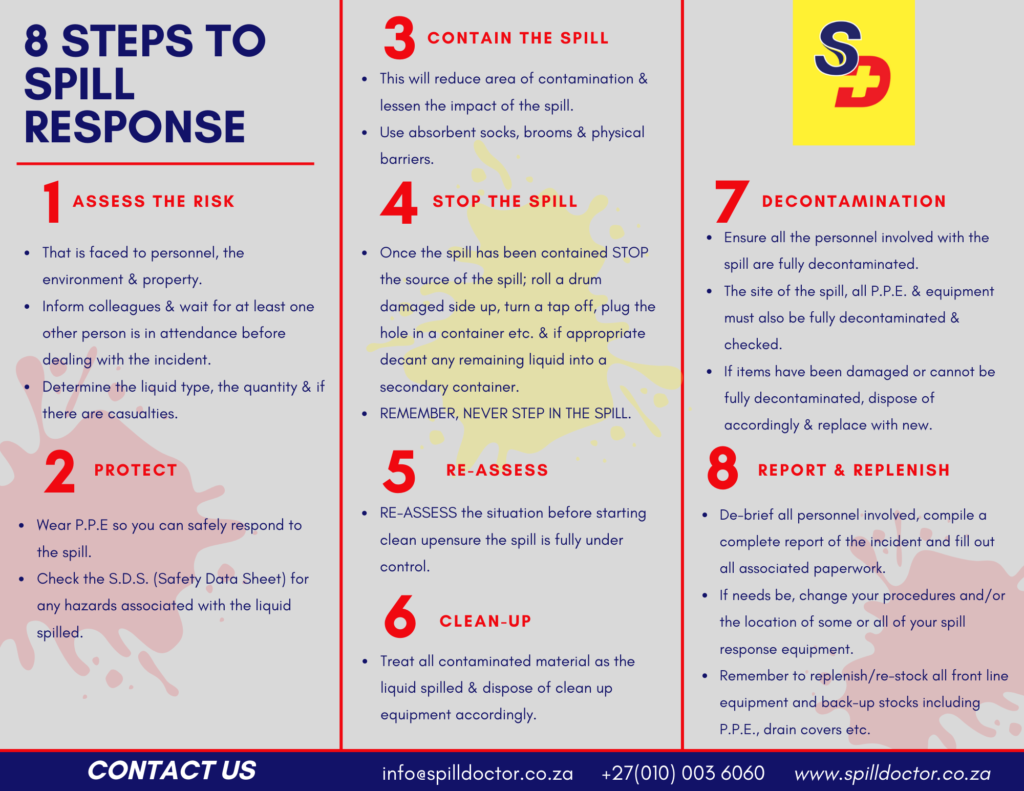What are the 5 C's of spill response?

When it comes to spill response, being prepared is crucial. Whether it's a small oil spill or a chemical leak, having a well-defined plan in place can minimize the impact on the environment and ensure the safety of individuals involved. One effective approach to spill response is the implementation of the 5 C's - a set of guidelines that help organizations handle spills efficiently and effectively. In this article, we will explore what the 5 C's of spill response are, why they are important, how to implement them, and some common challenges organizations may face.
What are the 5 C's of Spill Response?
The 5 C's of spill response are:
- Communication: Prompt and effective communication is essential in any spill response. It ensures that everyone involved is informed about the incident, understands their roles, and can take appropriate actions.
- Containment: Quick containment of the spill is crucial to prevent further spread and minimize the impact on the environment. This involves using appropriate barriers, booms, or absorbents to confine the spill to a specific area.
- Cleanup: Once the spill is contained, it needs to be cleaned up safely and efficiently. This may involve using specialized equipment, techniques, and trained personnel to remove the spilled material and mitigate any potential hazards.
- Coordination: Effective coordination among all parties involved in the spill response is vital to ensure a well-organized and efficient operation. This includes collaboration between internal teams, external agencies, and contractors, if necessary.
- Compliance: Adhering to relevant regulations, standards, and guidelines is crucial during spill response. It ensures that the spill is handled legally, ethically, and in a manner that protects the environment and the health and safety of individuals.
Why are the 5 C's important in spill response?
The 5 C's provide a structured framework for spill response, enabling organizations to respond promptly, efficiently, and effectively. By following these guidelines, organizations can minimize the potential environmental impact of spills, protect the health and safety of individuals involved, and mitigate financial and reputational risks.
How to implement the 5 C's in spill response?
Implementing the 5 C's requires careful planning, training, and ongoing evaluation. Organizations should:
- Develop a spill response plan that incorporates the 5 C's.
- Provide comprehensive training to employees on spill response procedures and their roles.
- Regularly review and update the spill response plan and procedures.
- Conduct drills and exercises to test the effectiveness of the spill response plan.
- Ensure access to appropriate spill response equipment and materials.
Common challenges in implementing the 5 C's
Implementing the 5 C's can come with its own set of challenges. Some common challenges organizations may face include:
- Lack of awareness and understanding of spill response procedures.
- Inadequate training and preparedness.
- Insufficient availability of spill response equipment and materials.
- Difficulty in coordinating with external agencies and contractors.
- Compliance with complex regulatory requirements.
Best practices for effective spill response
To ensure effective spill response, organizations should consider the following best practices:
- Regularly review and update spill response plans and procedures.
- Conduct regular training and drills to keep employees prepared.
- Establish clear communication channels and protocols.
- Maintain an up-to-date inventory of spill response equipment and materials.
- Collaborate with local authorities and emergency response agencies.
Conclusion
The 5 C's of spill response - Communication, Containment, Cleanup, Coordination, and Compliance - provide organizations with a comprehensive approach to handle spills effectively. By incorporating these guidelines into their spill response plans and procedures, organizations can minimize the impact on the environment, protect the health and safety of individuals involved, and ensure compliance with regulatory requirements.
Frequently Asked Questions
Q1: What is the first C in spill response?
The first C in spill response is Communication. Prompt and effective communication is essential to inform all parties involved about the spill, their roles, and the actions to be taken.
Q2: How does communication play a role in spill response?
Communication is crucial in spill response as it ensures that everyone is aware of the incident, understands their responsibilities, and can coordinate their actions effectively. It helps to prevent delays, confusion, and potential hazards.
Q3: What are the key considerations in containment during a spill response?
During spill response, key considerations in containment include using appropriate barriers, booms, or absorbents to confine the spill to a specific area, preventing further spread, and minimizing the impact on the environment.
Q4: Why is it important to consider the environmental impact during a spill response?
Considering the environmental impact during a spill response is crucial as it helps to minimize harm to ecosystems, wildlife, and natural resources. By implementing proper containment, cleanup, and compliance measures, organizations can mitigate the potential long-term consequences of spills on the environment.

Leave a Reply